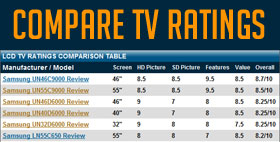LCD Monitors Vs CRT Monitors
"I've been staring at my computer for hours" is an often heard refrain, normally uttered in a zombie-like state. Of course, it's actually the monitor you are "staring" at, but for many of us the monitor is the computer. The right monitor should offer good image quality and a sizable viewing area while comfortably fitting your desktop space. Picking a monitor which combines these traits means you'll want to learn the basics about monitor features and technology. After a quick lesson, it'll be easy to choose a monitor that makes everything from spreadsheets to space aliens eye-popping and easy to read.Types of Monitors
CRTs
The most prevalent type of monitor today is the cathode ray tube (CRT). Despite its rather sci-fi sounding name, a CRT is the same as the picture tube inside your TV. They work by firing beams of electrons at phosphor dots on the inside of a glass tube. The phosphors in a CRT are chemicals that emit red, green or blue light when hit by electrons. These monitors are capable of multiple resolutions, give the best look to full-motion video and provide better control over colour calibration for graphic artists.
On the down side, they hog a lot of room and weigh more than several sacks of potatoes. You can get more compact CRTs called short-depth or short-neck monitors which are a couple of inches shallower than regular CRTs. Unless space is a primary consideration, most people buy a CRT display because they offer good performance at an affordable price.
LCDs
In the opposing corner are flat panel displays or LCDs (liquid crystal displays) commonly used in laptops and fast becoming popular as desktop monitors. Their major selling points are a slim profile and light weight. A CRT can be deeper than it is wide, whereas a LCD with a base is only about a handspan deep. No heavy lifting required with a LCD; they weigh less than half the average CRT. LCDs require half the power of CRTs and emit much less electromagnetic radiation which can interfere with other electronic devices.
In the screen of a LCD monitor, each pixel is produced by a tiny cell which contains a thin layer of liquid crystals. These rod-shaped molecules bend light in response to an electric current. It's the same display technology that resides in your digital watch but more sophisticated.
LCDs tend to be clearer than CRTs which can suffer from convergence or focus difficulties. Their improved clarity means that even small LCDs can display higher resolutions than the corresponding sized CRT. They also make small text easier to read. Unlike CRTs, LCD monitors have only one optimal resolution. At lower resolutions, the screen is redrawn as a smaller area or all the pixels in the image are blown-up to fill the screen. The latter solution can make images look jagged and blocky so be sure the resolution of the LCD is the resolution you want to use.
Size
Regardless of what type of monitor you're considering, size is a priority. A bigger monitor offers easier to read text, better graphics and the ability to have more and larger windows open on your desktop. All monitor sizes are measured diagonally across the screen, but that number isn't the true viewable area. The plastic frame around the monitor hides a certain amount of the screen so there is a difference between the quoted size and the actual viewable area. A monitor's viewable area should be within an inch or so of the quoted size.
Price
The standard monitor size used to be 15 inches, but 17-19 inch monitors have become the norm as prices have decreased. You can get a 17 inch CRT starting at $300. An adequate 19 inch CRT can be had for $400 but better quality will cost more. If you need a large screen for group presentations, a 29 inch monitor will cost a few thousand dollars. You can get a 29 inch PC/TV hybrid monitor for about $1000, but these monitors have low resolutions and are unable to produce high-quality images.
A LCD is about double the cost of a CRT with a comparable viewing area. The minimum size you should consider for a LCD is 15 inches with prices starting at $600. Larger LCDs go up in price from there with an 18 inch monitor costing around $3000. Buying a flat panel display will definitely leave your wallet flatter too.
Resolution
A factor for both CRTs and LCDs is resolution. The number of pixels horizontally and vertically defines a monitor's resolution in pixels or dots per inch (ppi or dpi). The greater the resolution, the more information or image you'll be able to view at once. The average user will find a resolution of 1024x768 more than sufficient for everyday work. You can achieve this resolution on CRT monitors 17 inches and larger or LCDs 15 inches and larger. Keep in mind that CRTs can display multiple resolutions, but LCDs are optimized at only one resolution.
Extras
Monitors can come with a variety of extras. Some have built-in speakers or jacks for microphones and headphones. Other monitors have dual inputs so you can connect two computers to the same monitor. With the advent of USB (Universal Serial Bus), some monitors have USB hubs at the back, allowing you to connect more peripherals. You can also get accessories like anti-glare filters and specialized mounting stands that help minimize glare and provide a comfortable working position.
Power Conservation
To keep your utility bill down, you should look for a monitor that is Energy Star compliant. Energy Star is a program developed by the US Environmental Protection Agency (EPA) to make energy-saving office equipment like computers and monitors. An Energy Star monitor automatically goes to sleep or powers down after a period of inactivity. This feature can save 60-80% of power during idle times. All you have to do to wake up the monitor is touch the keyboard or mouse.
Emissions
The majority of monitors are certified as "low emission" since they meet standards like MPR II or TCO. These guidelines were developed in Sweden (the acronyms are Swedish too) by a number of organizations to set limits for electric and magnetic field emissions. The newer TCO standards are the strictest. So if you're concerned about emissions look for MPR II or TCO certification, not just the words "low emission."
CRT Features
Refresh Rate
If you've decided to get a new CRT then it should have a sufficiently high refresh rate. This refers to how often the screen is redrawn per second. With low refresh rates you can get screen flicker and eye strain. Aim for a rate of 75 Hz for a monitor up to 17 inches in size and 85 Hz for any larger monitor. LCDs are basically flicker free so refresh rates aren't important.
Dot Pitch
Another consideration for CRTs is dot pitch. This is the distance in millimeters between phosphors of the same colour. The smaller the dot pitch, the sharper the image. Opt for a dot pitch of 0.26 mm or smaller. You can measure dot pitch both horizontally and vertically, but monitor specs usually quote horizontal dot pitch. Occasionally, the dot pitch is measured diagonally. By multiplying diagonal dot pitch by 0.866, you can calculate horizontal dot pitch.
LCD Features
Viewing Angle
One of the main disadvantages of LCDs when compared to CRTs is their limited viewing angle. When viewing a LCD straight on it looks fine. But the screen will appear washed-out if you move your head over to the side and look at it from an extreme angle. Low-end LCDs can have viewing angles of only 100 degrees which won't give everyone crowded round your desk a clear view. For a standard 15 inch LCD try to get a 140 degree viewing angle. Up that by 20-40 degrees when shopping for an 18 inch LCD.
Brightness
The brightness of LCD monitors is another important factor. LCD monitors have several backlights that provide illumination. Brightness is measured in units called nits. The majority of LCDs produce 150-200 nits which is fine for most users. The backlights in a LCD are good for 10 to 50 thousand hours of operation.
Since they're fairly fragile and more likely to break, backlights usually come with only a one year warranty. This warranty is separate from the one for the screen so you might want to extend the backlight warranty to match the duration of your screen warranty.
Positioning
LCDs can provide a range of options for positioning a display. The common way to view a screen is landscape mode (longer than wide). Some LCDs let you pivot the screen 90 degrees so you can view it in portrait mode (taller than wide) which is great if you're growing tired of scrolling so often. You should also check out whether the screen can both tilt and swivel. Easy adjustment is important if you'll be doing presentations. You can even mount some LCDs on the wall like a picture.
Flat Panel vs. CRT Monitors
As Flat Panels continue to drop in price, consumers have to choose between space-saving aesthetics or better-priced screen quality.
If space and aesthetics are important to you, then a flat panel is the way to go. Compared to CRT displays they use very little power, emit less heat and radiation, take up a smaller amount of space and are easy on the eyes.
If space is not an issue, it's probably better to get a good quality 19" CRT monitor than an entry-level 15" flat panel. As well, if you use your computer a lot for graphics and games, a CRT offers a sharper and more detailed display.
The best thing you can do is spend some time at an electronics store and put a flat panel through its paces. Open up Word and start typing, read the text and view images and video if possible.
If you're an apple enthusiast, you're in luck. The Apple flat panels are top of the line and display incredibly clear images, text and video. The price is steep but the results are worth it.









